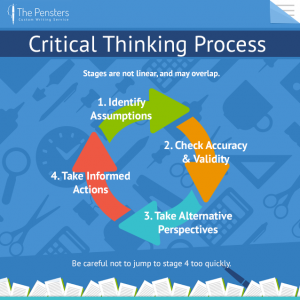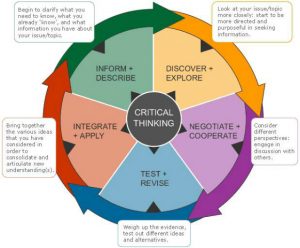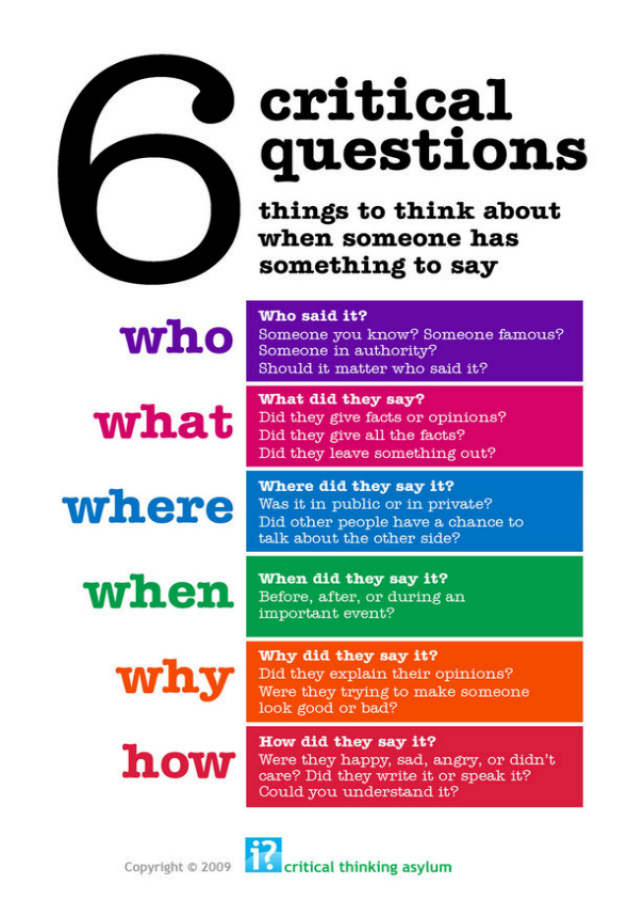The importance of critical thinking in academic work can hardly be overestimated. On the one hand, assignments on critical thinking constitute a considerable part of any curriculum. On the other hand, even when an assignment does not belong to this category, you are still expected to exercise your critical thinking abilities to successfully analyze information sources, make correct assumptions, take informed decisions and efficiently work with information. It means that improving your critical thinking will have a much broader use than you might think.
What Is Critical Thinking?
Thinking about the subject matter critically means perceiving the reading material with open and enquiring mind, not accepting anything at face value, being unbiased in your judgment and drawing objective conclusions as to whether the presented points of view are persuasive and trustworthy, based on the received information.

The most important features of good critical writing are as follows:
- refusal to accept the conclusions of the author unless they are backed by evidence, statistics or sound and logical reasoning. In other words, you doubt everything you read and consider everything that isn’t supported by facts to be false or at least unreliable;
- ability to clearly present the reasons why conclusions and arguments of another author or authors should be accepted or rejected. In other words, you should show the line of reasoning behind your evaluation of the written work in questions;
- presentation of your own arguments and conclusions that shows that your line of reasoning is feasible;</li
- understanding that your own conclusions, evidence and arguments have limitations.
What Does It Mean to Be Thinking Critically?
Successful critical thinking requires a set of skills or, rather, methods of dealing with problems. All of them are trainable, so the next time you write an essay, do your best to exercise these approaches to improve your performance in the long run:
- Understanding the connections between ideas, concepts, facts and statistical data. When you read or hear something, you don’t simply accept the explanations given by the author but analyze what you read or hear and try to draw your own picture, creating links between ideas and facts that the author may have omitted.
- Ability to evaluate the argumentation of others and build your own. By analyzing the logical soundness of arguments, you should be able to make an informed decision as to whether they are to be trusted or taken with a grain of salt.
- Systematic and consistent approach to problem solving. Critical thinking presupposes objective, analytical approach to dealing with problems. When you encounter an issue, you study the situation carefully, evaluate different points of view and their validity and draw a conclusion only after weighing all pros and cons. Instinct, intuition and preconceived assumptions don’t come into play at all.
- Ability to detect any inconsistencies and mistakes in reasoning. The author may be trying to confuse you intentionally, following his own agenda, or accidentally, through genuine errors in reasoning. Either way, you should be able to find weak spots and explain what is wrong with them.

Difference between Critical and Descriptive Writing
One of the main problems students experience when dealing with critical thinking writing is too vague understanding of the difference between it and descriptive writing. Many students have trouble expressing their own thoughts, their agreement or especially disagreement with the original text. That is why assignments on critical evaluation of a text all too often turn into mere descriptions.
Nevertheless, every critical paper is partially descriptive – a part of a critical paper is supposed to be dedicated to setting the background for your critical evaluation. The problem is that it is all too easy to let this part bloat and eat up most of your word limit. Therefore, when engaged in critical writing you should steer yourself in the right direction using following methods:
- evaluate the quality of proofs and arguments used in the text;
- mark the most important positive and negative aspects of the writer’s reasoning you can comment upon;
- define if they are relevant to the debate you are going to lead in your assignment;
- decide what would be the best way to introduce them into your own argumentation.
When you try to decide on the balance between the descriptive and the critical parts of your paper, try introducing only things that are absolutely relevant. It means that if you introduce something that you believe is relevant to your line of reasoning, you should explain to the reader why it is relevant.
You may think that it is only going to unnecessarily inflate the word count, but in truth, its effects will be diametrically opposite. On the one hand, it will make you think twice before introducing any descriptions – if you can’t explain why it is relevant, perhaps it isn’t relevant at all. On the other hand, by making a point of explaining how this piece of evidence contributes to your argument, you improve the critical part of your writing on the spot.
The Structure of Critical Thinking Writing
Critical writing doesn’t have any clear-cut, pre-determined structure – it is very dependent on the format of your particular assignment, its size and the subject matter. However, in most cases its structure can be boiled down to a more or less stable one:
- Introduction. Here you point out the basics of your topic. You should present the issue, explain why it is important, in what context it exists and what its potential consequences are. The introduction should close with a fragment outlining the following paper.
- Analysis. Define the concepts you are going to use and the method of analysis you are about to employ. Analysis is based on the examination of evidence you have at your disposal, breaking it down into constituent elements, defining their qualities and meanings and then reconstitution of these elements into a new whole. You should reconnect proofs scattered across the subject matter in a way that would prove your point of view. Remember, however, that healthy skepticism is the basis of critical thinking – question everything and don’t use it as a stepping stone for your reasoning unless you are sure you can prove it.
- Considering other viewpoints. Another important aspect of critical thinking is that you should never consider any perspective to be self-evident, however obvious it may seem to you. Neither should you expect it from your readers. Be ready to study the subject matter from different viewpoints, especially the ones that wildly contradict your own. Not only can other perspectives open up new vistas for deeper analysis, but it is also possible to uncover the weaker points of your own reasoning and patch them up at an early stage. If you know about points of view different from your own, study them. If there is any literature promoting these points of view, make sure to read or at least look through it.
Source: https://www.youtube.com/watch?v=9PsLktb7HTA
- Studying the contexts. Study the contexts in which the subject matter exists and single out the assumptions that are based on these contexts. Interpretation of the same text may differ greatly depending on cultural, religious and ideological biases, as well as your own experiences and beliefs. During this stage of your work, you are supposed to single out the influence contexts exercise over the perception of the subject matter, so that your analysis can be more objective and independent.
- Defining your own point of view. Expressing your own position may be either put into a separate section of the paper or spread across its entire body. In the first case, you do things part by part and prepare the foundation for your own viewpoint until that moment. In the second case, you introduce your own voice as a member of a discussion between different viewpoints whenever you discuss these conflicting perspectives. Both approaches have their pros and cons. The first one allows you to keep your entire line of reasoning tightly in one place. The second one allows for a more dynamic debate between different points of view.
- Conclusion. Just like in any other type of academic writing, you should recount what you’ve found out in the course of your work and point out the importance of the results of your research. Bring all the groundwork you’ve done to a logical conclusion and accentuate the importance of your work. If it is appropriate and applicable, you may provide a short outline of further possible study on the subject.
A Simple Algorithm to Set You Thinking Critically
If you have trouble evaluating an idea, piece of writing or something else, try using this simple sequence of 6 questions – it will help you view every assertion in context and get a broader perspective.
- Who wrote it?
Is the identity of the author relevant in this case? What is the position of the author? What is his relationship with the issue in question? Is he an authority on the subject? - What was written?
When boiled down to a minimum, what exactly was said? Did the author mention all the facts pertaining to the problem? Did he omit anything? Was what he said presented as a fact or an opinion? - Where was it written?
What is the source of the subject matter (book, speech, article, etc.)? What is its intended audience? - When was it written?
Is the time of writing relevant? Was the item written before, after or during an important event? - Why was it written?
What are the writer’s declared purposes? May he/she have another, hidden agenda? Does he/she try to make the situation (concept, idea, person) look in a certain light? - How was it written?
Does the author’s language, intonation, choice of words feel affected, emotional, sarcastic, angry or colored in any other way? Was it written in an obscure or cryptic manner? Was this way of writing intentional or not?

Source: http://www.knowledgereform.com/
Following these simple steps you will be able to start putting the subject matter apart and notice previously unseen connections between ideas, circumstances and the personality of the author.
Academic Voice for Critical Thinking Writing
Finding an academic voice that would be your own while possessing a certain predetermined set of qualities is probably more important in critical thinking writing than in any other line of academic work. The problem is, this kind of work requires careful balance – it is all too easy to overdo things and pass as bitterly cynical rather than healthily skeptical, for example.
- Be skeptical but not cynical. There is a difference between refusing to accept any judgment at face value and gleefully looking for (and finding) ulterior motives in any assertion made by the author.
- Back up your point of view. When you express an opinion, make sure to back it with facts, evidence and logical reasoning. Your professor is not so much interested in your opinion as in how exactly you’ve reached your conclusions.
- Be confident but not impertinent. Opposing and taking apart someone else’s opinions and reasoning requires assertiveness, but make sure you do it in a polite and respectful manner.
- Be unbiased. When you analyze someone else’s writing, be sure to evaluate both its weak and strong points fairly. It doesn’t matter whether you agree with what is said or not, like the author or not, want to disprove what is said or not. Be fair and don’t omit relevant information to make your own reasoning or that of the author look in a more or less favorable light.
https://www.youtube.com/watch?v=dBPseiuLI8o
Source: https://www.youtube.com/watch?v=dBPseiuLI8o
Try to Imagine Yourself in Your Reader’s Shoes
Try to imagine what it would be like for a stranger who doesn’t share your viewpoint to read your paper.
Why should he/she believe you?
Read your own writing just as critically as you read that of others. It can help you find logical gaps, faulty reasoning and just plain mistakes. If possible, ask somebody else to read your paper as well, just make sure to ask for as harsh critique as possible.
In the long run, our own critical thinking is only as good as it is ready to withstand the critical thinking of others.